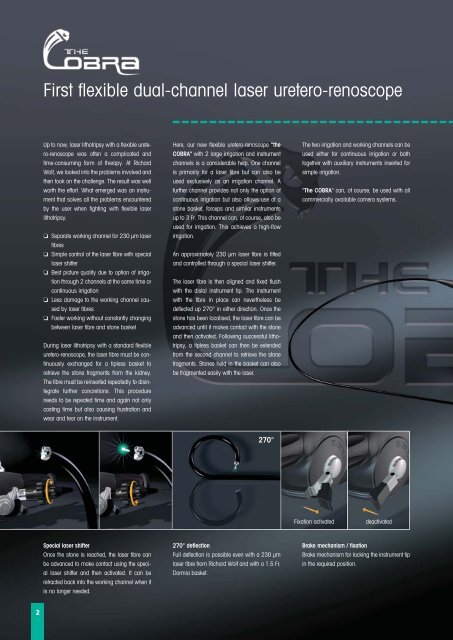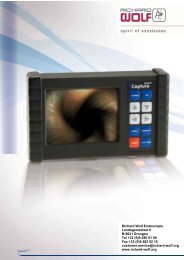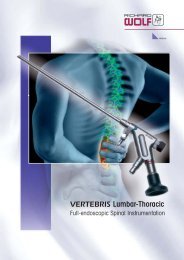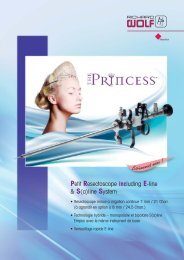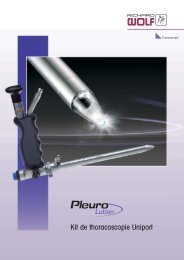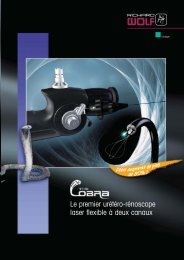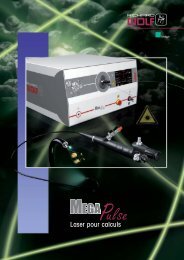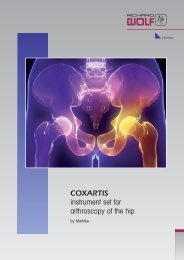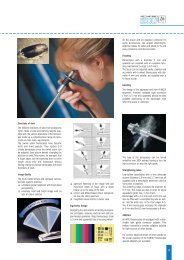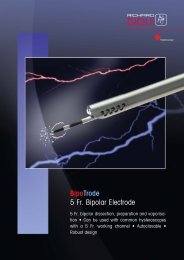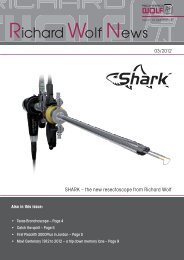First flexible dual-channel laser uretero-renoscope - Richard Wolf
First flexible dual-channel laser uretero-renoscope - Richard Wolf
First flexible dual-channel laser uretero-renoscope - Richard Wolf
You also want an ePaper? Increase the reach of your titles
YUMPU automatically turns print PDFs into web optimized ePapers that Google loves.
<strong>First</strong> <strong>flexible</strong> <strong>dual</strong>-<strong>channel</strong> <strong>laser</strong> <strong>uretero</strong>-<strong>renoscope</strong><br />
Up to now, <strong>laser</strong> lithotripsy with a <strong>flexible</strong> <strong>uretero</strong>-<strong>renoscope</strong><br />
was often a complicated and<br />
time-consuming form of therapy. At <strong>Richard</strong><br />
<strong>Wolf</strong>, we looked into the problems involved and<br />
then took on the challenge. The result was well<br />
worth the effort. What emerged was an instrument<br />
that solves all the problems encountered<br />
by the user when fighting with <strong>flexible</strong> <strong>laser</strong><br />
lithotripsy.<br />
❏ Separate working <strong>channel</strong> for 230 μm <strong>laser</strong><br />
fibres<br />
❏ Simple control of the <strong>laser</strong> fibre with special<br />
<strong>laser</strong> shifter<br />
❏ Best picture quality due to option of irrigation<br />
through 2 <strong>channel</strong>s at the same time or<br />
continuous irrigation<br />
❏ Less damage to the working <strong>channel</strong> caused<br />
by <strong>laser</strong> fibres<br />
❏ Faster working without constantly changing<br />
between <strong>laser</strong> fibre and stone basket<br />
During <strong>laser</strong> lithotripsy with a standard <strong>flexible</strong><br />
<strong>uretero</strong>-<strong>renoscope</strong>, the <strong>laser</strong> fibre must be continuously<br />
exchanged for a tipless basket to<br />
retrieve the stone fragments from the kidney.<br />
The fibre must be reinserted repeatedly to disintegrate<br />
further concretions. This procedure<br />
needs to be repeated time and again not only<br />
costing time but also causing frustration and<br />
wear and tear on the instrument.<br />
Here, our new <strong>flexible</strong> <strong>uretero</strong>-<strong>renoscope</strong> "the<br />
COBRA" with 2 large irrigation and instrument<br />
<strong>channel</strong>s is a considerable help. One <strong>channel</strong><br />
is primarily for a <strong>laser</strong> fibre but can also be<br />
used exclusively as an irrigation <strong>channel</strong>. A<br />
further <strong>channel</strong> provides not only the option of<br />
continuous irrigation but also allows use of a<br />
stone basket, forceps and similar instruments<br />
up to 3 Fr. This <strong>channel</strong> can, of course, also be<br />
used for irrigation. This achieves a high-flow<br />
irrigation.<br />
An approximately 230 μm <strong>laser</strong> fibre is fitted<br />
and controlled through a special <strong>laser</strong> shifter.<br />
The <strong>laser</strong> fibre is then aligned and fixed flush<br />
with the distal instrument tip. The instrument<br />
with the fibre in place can nevertheless be<br />
deflected up 270° in either direction. Once the<br />
stone has been localised, the <strong>laser</strong> fibre can be<br />
advanced until it makes contact with the stone<br />
and then activated. Following successful lithotripsy,<br />
a tipless basket can then be extended<br />
from the second <strong>channel</strong> to retrieve the stone<br />
fragments. Stones held in the basket can also<br />
be fragmented easily with the <strong>laser</strong>.<br />
The two irrigation and working <strong>channel</strong>s can be<br />
used either for continuous irrigation or both<br />
together with auxiliary instruments inserted for<br />
simple irrigation.<br />
"The COBRA" can, of course, be used with all<br />
commercially available camera systems.<br />
270°<br />
Fixation activated<br />
deactivated<br />
Special <strong>laser</strong> shifter<br />
Once the stone is reached, the <strong>laser</strong> fibre can<br />
be advanced to make contact using the special<br />
<strong>laser</strong> shifter and then activated. It can be<br />
retracted back into the working <strong>channel</strong> when it<br />
is no longer needed.<br />
270° deflection<br />
Full deflection is possible even with a 230 μm<br />
<strong>laser</strong> fibre from <strong>Richard</strong> <strong>Wolf</strong> and with a 1.5 Fr.<br />
Dormia basket.<br />
Brake mechanism / fixation<br />
Brake mechanism for locking the instrument tip<br />
in the required position.<br />
2


